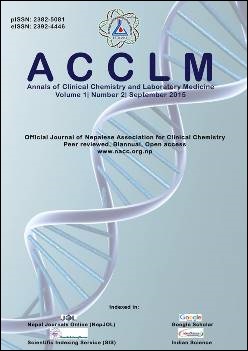Screening of New Born Babies for Thyroid Stimulating Hormone, Glucose-6-Phosphate Dehydrogenase, 17-Hydroxyprogesterone and Sickle Cell Disease
DOI:
https://doi.org/10.3126/acclm.v1i2.13253Keywords:
Thyroid stimulating hormone, 17-hydroxyprogesterone, Glucose-6 phosphate dehydrogenase, sickle cell, newborn screeningAbstract
BACKGROUND: The expanded newborn screening programme has now initiated worldwide. Many of the countries around the world made this programme mandatory. The effect of such screening system gives the advantage or betterment to the society as well as the nation.
METHODS: Samples were collected from babies aged 48-72 hours by heel prick method in a filter paper provided by Bio-Rad. The written consent was taken from the parents before collecting the blood samples. Blood samples were assayed for TSH and17-OHP by Enzyme Immuno Assay (EIA), G-6-PD was estimated by colorimetric assay provided by Bio-Rad Laboratories, USA and Sickle Cell Disease by sickling test
RESULTS: A total of 715 newborns were screened for TSH, G-6-PD, 17-OHP and Sickle cell disease. Out of which 1 neonate found abnormal (increased) thyroid stimulating hormone (1/715), and 8 neonates were G-6-PD deficient (8/715). We did not find any cases of congenital adrenal hyperplasia and sickle cell disease.
CONCLUSIONS: In this study the prevalence of Congenital Hypothyroidism and Glucose-6-Phosphate dehydrogenase deficiency was found to be 1:715 and 1:89 respectively. No cases of congenital adrenal hyperplasia and sickle cell disease were found.
Downloads
Downloads
Published
How to Cite
Issue
Section
License
Authors who publish with this journal agree to the following terms:
- The author transfers copyright to the Nepalese Association for Clinical Chemistry.
- The journal publishes the work under a Creative Commons Attribution License that allows others to share the work with an acknowledgement of the work's authorship and initial publication in this journal and under the same share-alike license used here.
- Authors are able to enter into separate, additional contractual arrangements for the non-exclusive distribution of the journal's published version of the work (e.g., post it to an institutional repository or publish it in a book), with an acknowledgement of its initial publication in this journal.
- Authors are permitted and encouraged to post their work online (e.g., in institutional repositories or on their website) prior to and during the submission process, as it can lead to productive exchanges, as well as earlier and greater citation of published work (See The Effect of Open Access).




